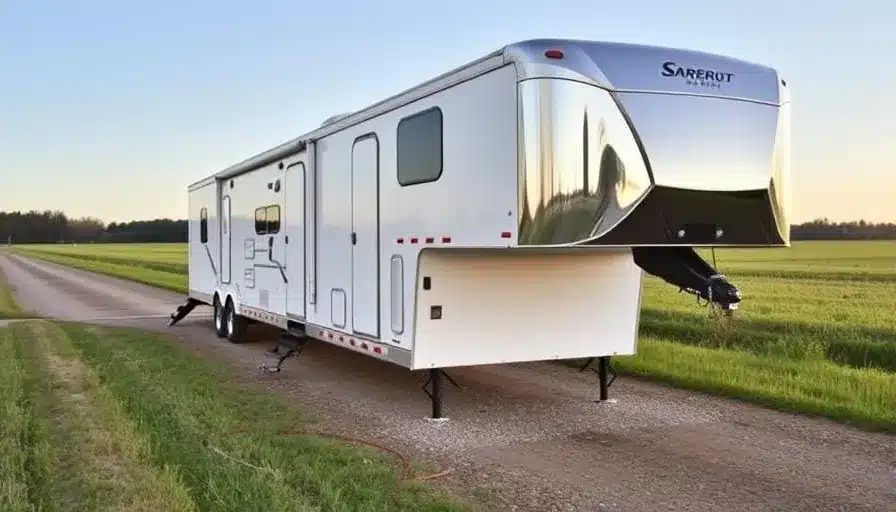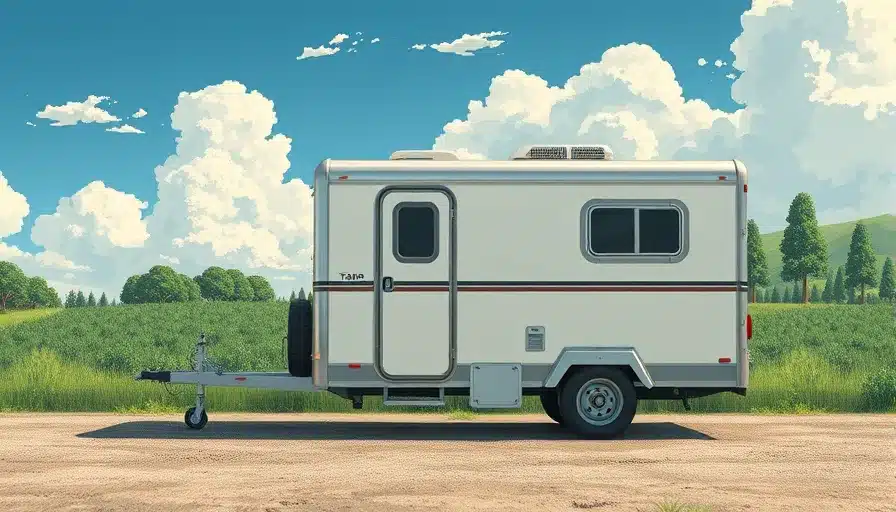

If you’re thinking about purchasing an enclosed trailer for your vehicle, you’re not alone. Enclosed trailers are very versatile and can help in various situations, like construction and hauling. While they’re long-lasting, these trailers can also be quite expensive. So, it’s essential to get it right the first time.
That’s why we’ve created an enclosed trailer size chart. Read on!
The first step to determining the right enclosed trailer size is checking out your GVWR, or Gross Vehicle Weight Rating. After all, regardless of the trailer size, your vehicle must be able to tow it. This rating tells you how much weight your vehicle can pull while maintaining safe driveability.
The net weight includes not only the vehicle’s weight but also accessories, passengers, fluids, fuel, and cargo. The GVWR is a fixed rating, and it’s prohibited to have trailers above the GVWR, which is punishable with fines and tickets. Typically, you can find information about your vehicle’s GVWR in the owner’s manual by contacting the manufacturer or, in some cases, on stickers on the driver’s door.
Before shopping for a new trailer, you can also calculate your load capacity by subtracting the trailer’s empty weight from the trailer GVWR. This equation will tell you the weight your vehicle can safely tow. So, if you’ve been wondering what size enclosed trailer for a car you should get, it depends on your vehicle’s GVWR.
Standard enclosed trailer sizes are between 5’ and 8.5’ wide. The width is measured from the outside of the box.
A five-foot trailer is already big enough for construction workers to store small tools. A six-foot trailer is capable of towing a few tons despite looking small. Small trailers are very convenient in urban areas, but a seven-foot trailer is still manageable, and it can carry higher weights while still maintaining good maneuverability. An 8.5-foot trailer is big enough to fit another vehicle into it.
Lengths also vary greatly, ranging from 8’ to 24’, but the interior height is usually 6’, although you may find variations. While shopping for your new trailer, remember it should have some extra interior space so that you can easily maneuver items inside. Here is an enclosed trailer size in terms of lengths:
| Wheelbase | Trailer Length | |
|---|---|---|

|
94′ | 16′ |
| 98′ | 17′ | |
| 102′ | 18′ | |
| 106′ | 19′ | |
| 110′ | 20′ | |
| 114′ | 21′ | |
| 118′ | 22′ | |
| 122′ | 23′ | |

|
126′ | 24′ |
| 130′ | 25′ | |
| 134′ | 26′ | |
| 138′ | 27′ | |
| 142′ | 28′ | |
| 146′ | 29′ | |
| 150′ | 30′ | |

|
154′ | 31′ |
| 158′ | 32′ | |
| 162′ | 33′ | |
| 164′ | 34′ | |
| 168′ | 35′ |
Additionally, consider the shape of the items you’re planning to fit into it, ensuring loading efficiency. Trailers are long-term investments, which means you need to consider not only your current needs but also anticipate future demands. If you think you might need more cargo space in the future, it’s advisable to plan your trailer size according to your future demands.
The choice of shape isn’t merely aesthetic. It also affects loading capacity, maneuverability, and customization options. Here’s what you need to know about the main features of V-nose and flat-front gooseneck trailers.
V-nose trailers typically range between 5’ and 8.5’ in width, but the nose isn’t included in the length. It means that if you see a 20’ V-nose trailer, its actual size is most likely about 22’. V-nose trailers provide easy towing and maneuverability, even on windy days or in tight spots.
The V-shaped front reduces drag and has better aerodynamics, resulting in more fuel efficiency. That’s why it’s an excellent option for long hauls. The 3D triangular shape of its front also provides extra space for storage. Some users even build entire working stations in this space.

Gooseneck trailers have a greater towing capacity and are perfect for handling hefty loads that are long or tall. This kind of trailer is mostly used on pickup trucks; it’s very stable and unlikely to tip over.
Typically, gooseneck trailers with dual wheels and axles weigh 10,000 lbs. Notice that it also affects the vehicle’s GVWR. They’re also longer than V-nose options, ranging between 8’x24’ and 8’x36’. Gooseneck trailers have a flat front, providing more floor space and customization options.
The enclosed trailer market has plenty of options regarding width, length, and height. Which one is the best for you? In the first place, it’ll largely depend on what you need it for. Learn more.
Standard hauling trailers are typically 8.5’ wide, which is big enough to fit a golf cart, a motorcycle, and even another car. Notice that there are different heights available, so you’ll need to calculate your hauling needs in advance. Additionally, pay attention to the ground clearance and make sure it’s enough to load and unload your cargo efficiently.
Enclosed trailers are perfect for storing items that need to be protected against the elements and provide extra protection against theft. Typically, 6’ and 7’ trailers are large enough for storage purposes. Better still, they are very maneuverable, meaning that you can easily carry your equipment around.
If you’re looking for a new enclosed trailer for construction work, you’ll be better off with 6’ or 7’ options. These trailers have enough space to fit your equipment and the maneuverability you need to drive around the working area.
Enclosed trailers are also perfect for landscaping work. However, you’ll need to consider how many mowers, tools, and other equipment you’ll need to carry. A 6’ wide is enough in most cases, though.
If you’re still unsure about the best front format for your enclosed trailer, there are a few factors you must consider, like the vehicle you’ll use, space, purpose, and driving distance. The vehicle must be able to handle the trailer when it’s fully loaded, not only the trailer itself.
V-nose options provide more storage space, and you can easily include a working station in them. While calculating the ideal square footage, you must also consider whether your need will scale up in the future. More importantly, your choice of format should also meet your demands. Flat front trailers are perfect as storage spaces, while V-nose options can be converted into workspaces.
Driving distances and road conditions must also be taken into account. V-nose trailers provide superior maneuverability and aerodynamics, making them more fuel-efficient. The difference in MPG is small, which means it doesn’t make much of a difference if you only travel short distances.
Flat-front trailers are more affordable V-nose options and are perfect if you don’t need to travel far or have too much equipment. V-nose options offer advantages like enhanced mileage, more space, driveability, and extra storage space. They also allow you to bring your workspace with you wherever you go.
Tandem axles use a pair of wheels instead of only one wheel. They’re more expensive because they provide improved stability and maneuverability, can handle heavier loads, and provide better traction while traveling at highway speeds. However, single axles have lower maintenance costs, require less repair, and are also more fuel-efficient.

At Millennium Trailers in Indianapolis, IN, you’ll find the best deal for your enclosed trailer. If you cannot find a trailer that fits your budget and needs, you can easily customize your ideal trailer with the capacity and features you need for work or personal use.
Contact us today to learn more about our offers and conditions, or browse our inventory to learn more.
Millennium Trailers is your trusted partner for high-quality trailers at unbeatable prices. Serving all 50 states, we’ve delivered over 5,000 trailers nationwide.
Established in 1998, we’re a company dedicated to meeting your hauling needs with excellence. Whether it’s cargo trailers or custom living quarters, we provide a wide range of options to suit your requirements. Our knowledgeable and friendly team ensures a smooth buying experience with personalized assistance. Proudly offering competitive pricing, state-of-the-art designs, and easy financing options. Committed to customer satisfaction, we strive to simplify the process of finding your perfect trailer.
Choose Millennium Trailers for a reliable, customized solution that delivers quality and value for your investment.
Copyright 1998 – 2023 Millennium Trailers, Inc.